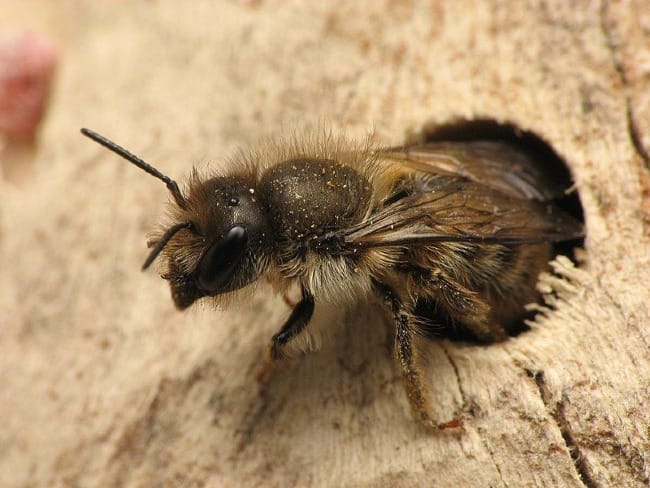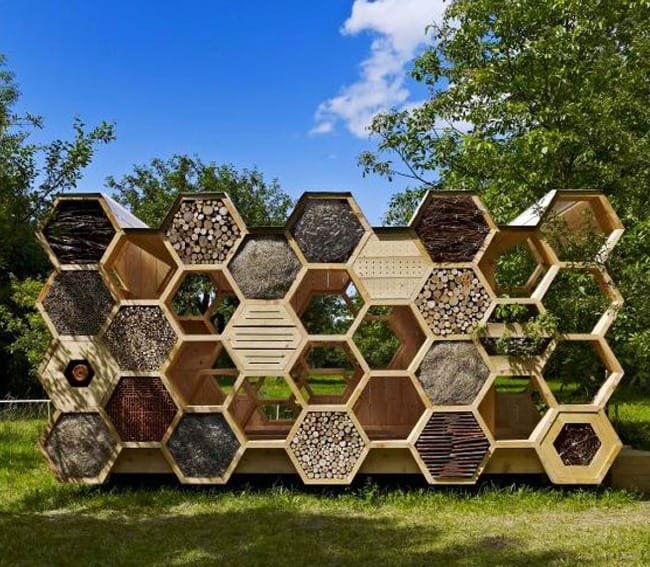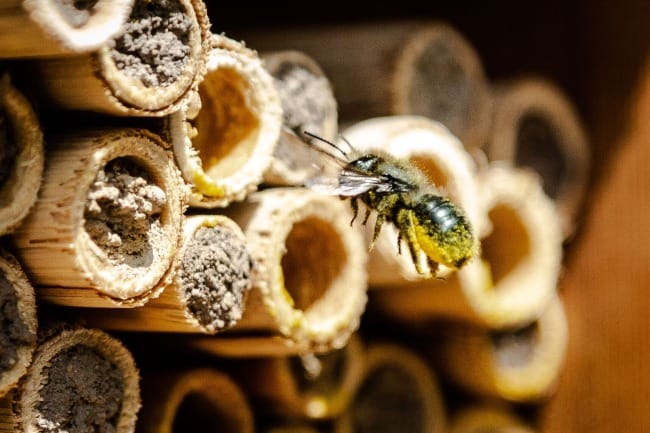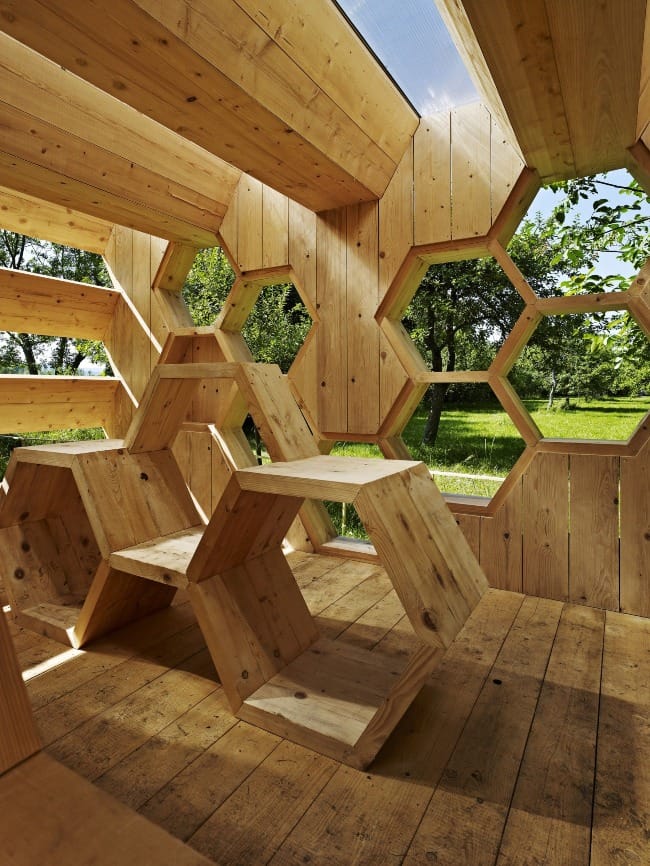This piece of art both invites the viewer to marvel at the tiny creatures called bees and also invites those bees themselves to inhabit its walls, transforming itself into a living work of art.
The Colony Collapse disorder which threatens honeybees across much of the U.S. and Europe is also devastating native bee populations, although that is less publicized. Honeybees, non-native to the U.S., were brought from Europe by colonists about 400 years ago and largely due to the honey they produce which is enjoyed and used by many (I myself have many fond childhood memories of chewing on honeycombs from our beehive and selling jars of honey by the roadside), honeybees have become the most familiar and valued bee in the U.S. and elsewhere. But native bees, which are often solitary rather than hive creatures, and thus don't produce a consumable such as honey, are extremely important and efficient pollinators for many plants that honeybees can't pollinate and are important contributors to a healthy ecosystem.

Because many native plants have co-evolved with specific bees, they are dependent upon each other for their mutual survival. Across the world, native bees are being threatened, sometimes to extinction and, although the exact equation of blame isn't known, several human-caused factors are believed to be responsible for the problems. Nesting site destruction, pesticides and the decimation of native plants are all significant factors in the declining native (and honeybee) populations.
Many architects have worked to raise awareness of the problem and also help wild bees thrive by creating, in cities and rural areas around the world, bee hotels which provide nesting cavities for different types of bees. The bee hotel below is one of my favorites.

Built by AtelierD of Sélestat, France, this 215 square foot pavilion for bees was built during the 2012 Muttersholtz Archi Festival, an architecture and design show in northeastern France which focuses on sustainable building and eco-tourism. The K-Abeilles Hotel replicates the variety of nooks that lodge different types of wild bees, including mason bees, leafcutters, mining bees, carder bees, and carpenter bees, thus creating safe nesting spots for a wide variety of bee inhabitants.
The wooden pavilion features one wall of honeycomb-shaped compartments, each filled with different pieces of bricks, twigs, reeds, bark, and hay. The densely packed materials create ideal places for wild bees to nest. Solitary bees, which lay their eggs in small holes, such as those provided, pack each hole with pollen and nectar for the offspring to eat once it has hatched. Once a female bee has laid an egg or group of eggs inside, she makes a mud “door” to cover the entrance hole. Then, after each bee hatches, it will eat the supply of pollen surrounding it until it is mature enough to break through the mud and fly away.

On the opposite side of the pavilion from the bee nesting space, is a different type of habitat. This side provides human habitat, using the same hexagonal panels as the side designed for bees, with hexagon-shaped windows open to the outside. These hexagon shapes also form benches and cubbies for the human visitors and from these benches the visitors can watch the movements and habits of the bees, sharing what appears to be an oversized beehive with the very creatures they are watching.

Solitary bees are much less likely than honeybees to sting since they aren't defending a hive, so the danger of being bothered by these cohabitants is actually small. Many solitary bees only sting if they are pinched between fingers or are put in some other immediate physical danger.
If a person wants their own bee hotel, they do come in all sorts of shapes and sizes; all require upkeep since disease and harmful mites can spread if the spaces aren't carefully cleaned and maintained.
Beyond the Bee Hotel
In addition to properly well-maintained bee hotels, there are other ways to help native bees (and other pollinators) by counteracting the dangers they face from destroyed nesting sites, pesticides, and the destruction of native plants.
Avoiding thick layers of mulch or large expanses of lawn and extensive pavement can help ground nesting bees. Mulching with compost, reducing tilling (which can kill ground nesting bees), and using non-flowering buffers to separate nesting areas from other areas where pesticides are used, are also significant helps people can provide. Plants with pithy stems, such as raspberries, provide excellent habitat for small carpenter and other cavity-nesting bees. Bumblebees use small piles of brush such as hedge clippings and woody plant material to nest within. Leaving leaf litter in gardens improves the soil and provides cover for overwintering queens.
Some of the bees' biggest problems are caused by current agricultural methods. When people "efficiently" eradicate everything but the desired crop, including buffer zones and edges, leaving only one monolithic crop, many plants that fed pollinators are wiped out. Plants aren't interchangeable to all bees, so planting a variety, especially native plants that bees and other pollinators have adapted to and depend upon, is important in helping bees thrive.
If you need an added incentive for taking care of bees, here is a scripture to consider:
“You shall not muzzle an ox when it is treading out the grain.” Deuteronomy 25:4
In other words, when a creature is working to produce something for you, it should have a share in the abundance it is helping to provide. Bees have a huge part in our food production and if we are to think of the needs of the ox, I believe we are to think of the needs of the bee as well.
The most dangerous threats to bees are pesticides, which, in addition to killing the target pest, also harms pollinators and other beneficial insects. Pesticide contamination is extremely widespread (it has been found in 90% of pollen samples from beehives in agricultural landscapes [1] and more than 90% of stream samples [2]). It is critical that we try to reduce our use of pesticides and minimize the risk of pesticides to pollinators where pesticides are used. Pesticides shouldn't be used indiscriminately or carelessly because of the danger they pose to so many living creatures, including ourselves. When considering pesticide use, here is another scripture to think about first.
How many are your works, LORD! In wisdom you made them all; the earth is full of your creatures. Psalm 104:24
Reflection Questions: Do you have a place where you can watch the activity of some creature that pays no attention to you? Is there something you can do to support a creature that is unobtrusive, yet important to the whole ecosystem?
Louise
Feel free to contact me directly at info@circlewood.online
To learn more about native bees in the U.S., click here. For other ideas on helping your local bees and other pollinators, visit the Xerces Society website here. To learn about some major efforts to help bees around the world, visit here.

[1] High Levels of Miticides and Agrochemicals in North American Apiaries: Implications for Honey Bee Health, Published: March 19, 2010, https://doi.org/10.1371/journal.pone.0009754